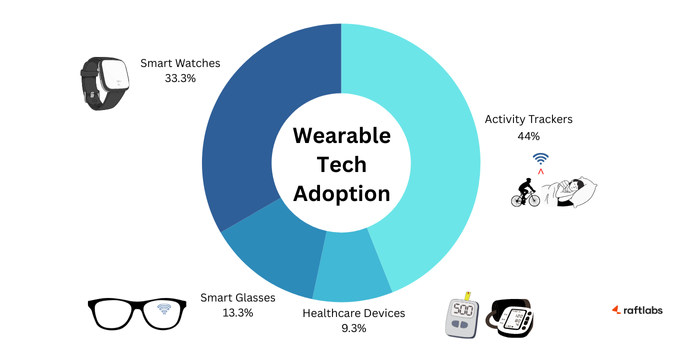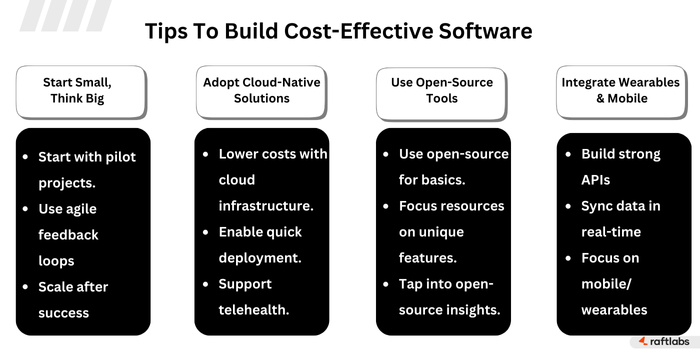
An In-Depth Look at Custom Software Development for Healthcare With AI
- Healthcare
- Last updated on
The intersection of healthcare and technology is no longer a distant vision—it’s happening right now. As the digital health market is projected to surpass $660 billion by 2025, driven by innovations in AI, wearables, and mobile health solutions, the opportunity for developers and investors alike is immense.
Wait —- How can we tap into this booming market?
Even though the potential to transform patient care is enormous, there are significant challenges that need to be addressed, including data security, costs, and accessibility.
From wearables that monitor heart rates to AI systems predicting patient outcomes, healthcare is experiencing a revolution.
Are we truly ready for these innovations to deliver on their promises?
Or will we encounter obstacles that slow progress?
In this article, we’ll explore the complexities of the healthcare tech landscape, highlighting the challenges, opportunities, and cutting-edge solutions shaping the future.
If you’re looking to develop health tech software that makes an impact, this is the space to be.
Keep reading to discover how we can navigate this exciting, rapidly evolving field together.
The Healthcare Technology Paradox
At the heart of healthcare lies an intriguing paradox.
On one hand, global healthcare IT spending is projected to reach $974.5 billion by 2027.
Yet, around 70% of digital transformation initiatives in healthcare fail to reach their objectives.
What’s holding back these initiatives from achieving their full potential?
Let�’s look at the reality healthcare providers are grappling with.
A Reality Check: Key Challenges in Healthcare Technology
The current landscape in healthcare technology presents critical obstacles:
Integration Issues: Hospitals often manage over 15 different electronic systems, which leads to communication challenges and slows down operations.
Preventable Errors: An estimated 86% of healthcare errors are administrative or preventable, resulting in additional costs and complications.
Underutilized Data: Despite accumulating extensive data, only 3% of hospitals fully utilize this information to drive improvements.
EHR Burden: Providers spend an average of 4.5 hours daily on electronic health records (EHR) tasks, taking time away from patient care.
Together, these challenges highlight the pressing need for smarter, more integrated healthcare solutions.
Breaking Down the Healthcare Technology Ecosystem
The healthcare tech ecosystem is complex yet full of promise.
From the intricacies of developing new solutions to the real-world impact they’re having, each piece plays a role in enhancing patient care.
To understand this ecosystem better, let's break down the main components.
Electronic Health Records (EHRs)
Centralized, digital systems that store patient medical history, test results, treatment plans, and more.
EHRs streamline information sharing across healthcare providers, improving patient care and operational efficiency.
Telemedicine Platforms
Enable remote consultations, diagnostics, and treatment through video calls or messaging.
Extend healthcare access to rural or underserved communities, while reducing patient travel time.
Wearable and IoT Health Devices

Include smartwatches, fitness trackers, and specialized health monitors.
Allow real-time tracking of vital signs, fitness levels, and health metrics for both preventive care and chronic disease management.
Healthcare Apps and Patient Portals
Apps that give patients access to health information, appointments, and remote health monitoring.
Patient portals facilitate self-management of health, making care more patient-centric and accessible.
Clinical Decision Support Systems (CDSS)
Software that helps healthcare professionals make informed decisions by analyzing clinical data.
CDSS improves diagnostics, minimizes errors, and enhances personalized treatment options.
Artificial Intelligence and Machine Learning Models
AI is applied in diagnostics, predictive analytics, and patient management.
Helps in identifying patterns, predicting health risks, and automating routine tasks, improving both efficiency and care quality.
Data Analytics and Predictive Analytics
Aggregates and analyzes vast amounts of health data to uncover trends and make predictions.
Informs better decision-making, preventive measures, and early intervention strategies.
Interoperability Standards and APIs
Standards like HL7 and FHIR, along with APIs, ensure data can be easily shared across systems.
Allow various healthcare software to "communicate," making data available when needed for care coordination.
Cybersecurity Systems
Critical for safeguarding patient data and meeting regulatory standards like HIPAA and GDPR.
Protects against breaches and unauthorized access, ensuring patient confidentiality and trust.
Cloud Computing and Storage Solutions
Provide scalable and secure storage for massive healthcare data sets.
Support telemedicine, mobile health, and secure data sharing across healthcare organizations.
Regulatory Compliance and Quality Assurance Systems
Ensure all technology complies with healthcare regulations and quality standards.
Maintains patient safety, data privacy, and adherence to legal requirements.
Navigating the Unique Challenges of Healthcare Software Development
Developing healthcare software isn’t just about coding; it’s about navigating a landscape full of unique challenges:
Regulatory Compliance: Strict regulations like HIPAA, GDPR, and FDA guidelines steer the development process, ensuring each solution prioritizes safety and privacy.
Interoperability Needs: Standards like HL7 and FHIR enable different systems—such as hospital records and fitness trackers—to communicate effectively, a crucial aspect of efficient patient care.
Legacy System Integration: Many health institutions rely on decade-old IT systems, so balancing upgrades with existing infrastructure is key to a smooth digital transformation.
Consumer Tech Integration: With wearables generating massive amounts of data, the challenge is to use this information effectively while maintaining privacy.
The AI Revolution in Healthcare: Building Smarter, Cost-Effective Solutions
In today’s digital era, AI and healthcare are joining forces to deliver transformative results. From predictive analytics to wearable integration, AI is reshaping healthcare for better outcomes and efficiency. Here are some remarkable examples:
University of Kansas Health System used predictive analytics to reduce diabetes-related readmissions from 25% to 13.9% through focused interventions.
University of California, San Francisco achieved remarkable precision in diagnostics, reaching 97% accuracy in identifying abnormal heart rhythms by integrating wearable data with AI-driven algorithms.
Rush University Medical Center leveraged predictive modeling to reduce "Left Without Being Seen" (LWBS) rates by 67%, identifying patients at risk and improving timely care.
AdventHealth Waterman significantly cut MRI scan times by 30-50% with advanced AI technology, enhancing patient throughput and efficiency.
As we explore the role of AI in healthcare, we see how technology is shaping a smarter, more responsive healthcare system.
Practical AI Applications Transforming Healthcare
AI is driving change in several areas, each enhancing healthcare experiences in unique ways:
- Clinical Decision Support: From diagnostics to managing drug interactions, AI enables personalized care for patients.
- Administrative Efficiency: AI reduces administrative tasks, allowing healthcare staff to focus on patient care.
- Patient Engagement: Real-time health insights and tailored recommendations encourage patients to actively manage their health.
- Wearable Integration: Wearables now provide real-time health data, helping prevent health issues before they escalate.
These applications underscore how AI isn’t just a tool; it’s an essential element in building future-ready healthcare solutions.
The Role of Custom Software Development in Healthcare
For healthcare organizations, incorporating AI effectively requires more than just off-the-shelf solutions.
Custom healthcare software development is crucial. Tailored to meet the specific needs of healthcare providers, custom solutions navigate the complexities of regulatory requirements and interoperability challenges.
In healthcare, software isn’t simply about functionality—it’s a gateway to better patient outcomes and operational efficiency.
Whether you’re a provider looking into custom solutions or a patient benefiting from integrated wearables, custom software helps transform these digital tools into practical, life-enhancing solutions.
A Short Guide to Cost-Effective Healthcare Software
Creating impactful healthcare technology requires a strategic, budget-conscious approach.
Here’s a roadmap to building cost-effective healthcare software that delivers real value.

Start Small, Think Big
Begin with small pilot projects to validate ROI before committing fully.
Use agile methodologies with short sprints and continuous feedback for flexibility.
Scale thoughtfully once pilot success is proven.
Embrace Cloud-Native Architecture
Lower total cost of ownership, faster deployment, and built-in scalability.
Supports remote healthcare delivery, ideal for telehealth demands.
Keeps operational costs manageable.
Leverage Open-Source Technologies
Use established frameworks for non-critical components to save resources.
Focus development efforts on features that add unique value.
Engage with open-source communities for insights and standards.
Integrate Wearable and Mobile Devices
Ensure solutions include robust APIs, scalable storage, and real-time sync.
Provides easy access to healthcare data when and where needed.
Essential for mobile-first and wearable-integrated healthcare environments.
Prioritizing Security: Smart Risk Mitigation
With data breaches costing healthcare providers $408 per record on average, prioritizing security is essential.
Implementing a zero-trust approach, end-to-end encryption, and stringent device security are necessary measures to protect sensitive patient information and maintain compliance.
Measuring Success Beyond Deployment
The effectiveness of healthcare software goes beyond just rolling it out. Key metrics to evaluate include:
Clinical Metrics: Assess treatment outcomes and workflow efficiency.
Technical Metrics: Monitor system uptime and data accuracy.
User Engagement: Gauge provider satisfaction and patient engagement levels.
Financial Metrics: Calculate ROI and cost savings achieved through automation.
These metrics ensure that software not only meets technical standards but also delivers on its intended impact.
Future-Proofing Your Healthcare Software Investment
In a field where technology evolves rapidly, keeping your software relevant is critical.
Modular architecture, regular updates, and emerging tech integration (such as AI/ML and IoT) allow healthcare solutions to adapt to new demands without extensive overhauls.
The Path Forward
Building effective healthcare solutions hinges on making smart, strategic choices. Defining clear goals, aligning stakeholders, and focusing on security and integration are foundational steps toward creating software that truly benefits patients and providers alike.
Imagine a world where technology enables healthcare to reach everyone, making care more accessible, efficient, and compassionate.
Every step toward innovation in healthcare is a step toward that vision—a future where quality care is a right, not a privilege.
Have a healthcare tech idea you’re eager to bring to life?
Whether it’s modernizing existing systems or launching a new concept, we can help you navigate the complexities of healthcare app development cost-effectively.
Let’s work together to shape a future where technology and healthcare align for a better tomorrow.


